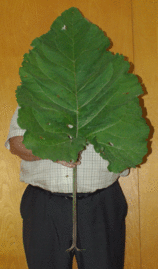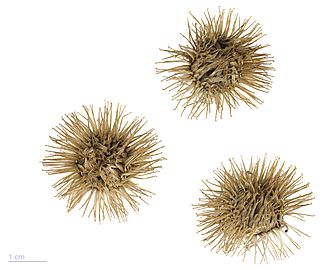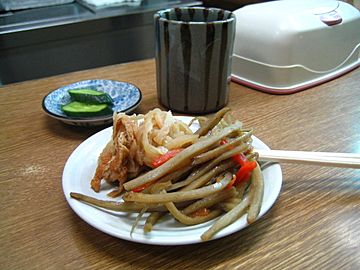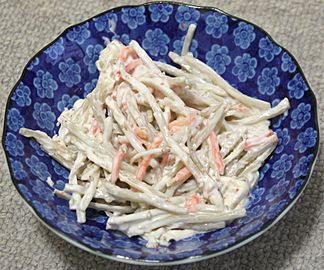Greater burdock facts for kids
Quick facts for kids Greater burdock |
|
|---|---|
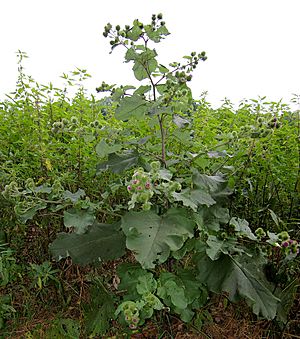 |
|
| Greater burdock | |
| Scientific classification | |
| Genus: |
Arctium
|
| Species: |
lappa
|
| Synonyms | |
|
Synonymy
Arcion majus Bubani
Arcion tomentosum Bubani Arctium bardana Willd. Arctium chaorum Klokov Arctium grandiflorum Desf. Arctium leiospermum Juz. & Ye.V.Serg. Arctium majus (Gaertn.) Bernh. Arctium ruderale Salisb. Arctium vulgare (Hill) Evans Arctium vulgare (Hill) Druce Bardana arctium Hill Bardana lappa Hill Lappa glabra Lam. Lappa major Gaertn. Lappa nemorosa (Lej.) Körn. ex Griewank Lappa officinalis All. Lappa vulgaris Hill Lappa platylepis Boiss. & Balansa ex Boiss. & Balansa |
|
Greater burdock, also known as Arctium lappa, is a plant that originally comes from Europe and Asia. You might hear it called gobō in Japan, or edible burdock. People grow it in gardens for its long root, which is eaten as a vegetable. In some places like North America and Australia, it has become a common wild plant, especially in rich soils.
Contents
About Greater Burdock
Greater burdock is a plant that lives for two years. It can grow very tall, sometimes reaching up to 3 meters (about 10 feet)! It has large, heart-shaped leaves with wavy edges. These leaves have long stems and feel fuzzy on the underside.
Flowers and Seeds
The flowers are purple and grow in round clusters. They usually appear in the middle of summer, from July to September. These flower clusters are surrounded by many small, hooked parts called bracts. These hooks are very clever! When the seeds are ready, these hooks grab onto the fur of animals, helping the seeds travel far away.
The seeds themselves are small and have tiny, sharp hairs. These hairs can easily break off and stick to skin, clothes, or even get into eyes, causing a bit of irritation. The plant also has a thick root that can grow deep into the ground, sometimes as long as 1 meter (about 3 feet).
Similar Plants
It's important not to confuse burdock with rhubarb, because rhubarb leaves are poisonous.
Where Burdock Grows
This plant is native to many parts of the world, from cold Scandinavia to the warm Mediterranean Sea. It also grows across the British Isles, Russia, the Middle East, India, China, Taiwan, and Japan.
Greater burdock can now be found almost everywhere. It often grows in places where the ground has been disturbed, like roadsides or empty lots. It especially likes soil that is rich in nutrients and gets plenty of sunlight.
Burdock in Nature
The leaves of greater burdock are a food source for the young caterpillars of some moths, like the thistle ermine moth.
How People Use Burdock
Greater burdock is grown in Japan for its root. It even gave its name to a special building method called burdock piling.
Burdock as Food
| Nutritional value per 100 g (3.5 oz) | |
|---|---|
| Energy | 302 kJ (72 kcal) |
|
17.34 g
|
|
| Sugars | 2.9 |
| Dietary fiber | 3.3 g |
|
0.15 g
|
|
|
Protein
|
1.53 g
|
| Vitamins | Quantity
%DV†
|
| Thiamine (B1) |
1%
0.01 mg |
| Riboflavin (B2) |
3%
0.03 mg |
| Niacin (B3) |
2%
0.3 mg |
| Pantothenic acid (B5) |
6%
0.321 mg |
| Vitamin B6 |
18%
0.24 mg |
| Folate (B9) |
6%
23 μg |
| Vitamin C |
4%
3 mg |
| Vitamin E |
3%
0.38 mg |
| Vitamin K |
2%
1.6 μg |
| Minerals | Quantity
%DV†
|
| Calcium |
4%
41 mg |
| Iron |
6%
0.8 mg |
| Magnesium |
11%
38 mg |
| Manganese |
11%
0.232 mg |
| Phosphorus |
7%
51 mg |
| Potassium |
10%
308 mg |
| Sodium |
0%
5 mg |
| Zinc |
3%
0.33 mg |
|
Link to USDA Database entry
|
|
| †Percentages estimated using US recommendations for adults. | |
The roots of greater burdock are edible when cooked. They are very popular in Japan, Korea, and Taiwan, where they are known as gobō or ueong. In Europe, people used to eat it a lot during the Middle Ages, but now it's mostly eaten in Italy, Portugal, and Brazil.
The roots are grown to be long and thin, about 1 meter (3 feet) long and 2 centimeters (about 1 inch) wide. In Britain, the root was traditionally used to flavor a drink called dandelion and burdock, which you can still buy today.
Burdock root is crunchy and has a slightly sweet, mild, and earthy taste. If you soak the shredded roots in water for a few minutes, it can make the taste milder. This earthy flavor goes well with pork in Japanese miso soup (called tonjiru) or in mixed rice dishes (takikomi gohan).
A very popular Japanese dish is kinpira gobō. This is made by stir-frying shredded burdock root and carrots with soy sauce, sugar, and other seasonings. Another dish is burdock makizushi, which is rolled sushi filled with pickled burdock root. Sometimes, the burdock root in sushi is even colored orange to look like a carrot! You can also find burdock root as a fried snack, similar to potato chips, or as an ingredient in tempura dishes.
The tender stems of the leaves can be peeled and eaten raw or cooked. Even the young flower stalks can be picked in late spring before the flowers open. They taste a bit like artichoke, which is a plant related to burdock.
In the last part of the 20th century, burdock became more famous around the world because of the popularity of the macrobiotic diet. This diet suggests eating burdock often. The root has a good amount of dietary fiber, calcium, potassium, and amino acids, and it's low in calories.
Traditional Uses
Dried burdock roots are used in traditional medicine in some cultures. For example, the seeds of greater burdock are used in traditional Chinese medicine for various health purposes.
See also
 In Spanish: Arctium lappa para niños
In Spanish: Arctium lappa para niños



